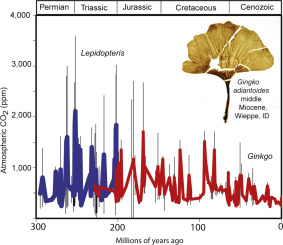当前位置:
X-MOL 学术
›
Glob. Planet. Change
›
论文详情
Our official English website, www.x-mol.net, welcomes your
feedback! (Note: you will need to create a separate account there.)
Deep time perspective on rising atmospheric CO2
Global and Planetary Change ( IF 4.0 ) Pub Date : 2020-06-01 , DOI: 10.1016/j.gloplacha.2020.103177 Gregory J. Retallack , Giselle D. Conde
Global and Planetary Change ( IF 4.0 ) Pub Date : 2020-06-01 , DOI: 10.1016/j.gloplacha.2020.103177 Gregory J. Retallack , Giselle D. Conde

|
Abstract The accuracy of CO2 hindcasting using fossil Ginkgo stomatal index is ripe for revision for three reasons: exponential rise in atmospheric CO2 over the past decade, discovery of a Kew herbarium specimen of Ginkgo picked in 1754, and increased sophistication of a pedogenic CO2 paleobarometer as an independent parallel record. Past mass extinctions coincide with revised CO2 spikes of 1500 ppm or more. Increases such as the middle Miocene level of 640 ± 71 ppm expected before the year 2100 resulted in biome shifts, with expansion of tropical forests northward, and of grasslands into deserts. Deep time records from paleosols and from stomatal index reveal that CO2 levels less than 180 ppm and more than 1500 ppm are toxic to the biosphere.
中文翻译:

大气 CO2 上升的深度时间透视
摘要 由于三个原因,使用化石银杏气孔指数进行 CO2 后测的准确性已经成熟,原因有以下三个:过去 10 年大气 CO2 呈指数上升,发现 1754 年采摘的 Kew 银杏植物标本馆标本,以及作为独立的平行记录。过去的大规模灭绝与修订后的 1500 ppm 或更高的 CO2 峰值相吻合。预计在 2100 年之前中中新世水平增加 640 ± 71 ppm,导致生物群落转移,热带森林向北扩张,草原向沙漠扩张。来自古土壤和气孔指数的深度时间记录显示,低于 180 ppm 和超过 1500 ppm 的 CO2 水平对生物圈是有毒的。
更新日期:2020-06-01
中文翻译:

大气 CO2 上升的深度时间透视
摘要 由于三个原因,使用化石银杏气孔指数进行 CO2 后测的准确性已经成熟,原因有以下三个:过去 10 年大气 CO2 呈指数上升,发现 1754 年采摘的 Kew 银杏植物标本馆标本,以及作为独立的平行记录。过去的大规模灭绝与修订后的 1500 ppm 或更高的 CO2 峰值相吻合。预计在 2100 年之前中中新世水平增加 640 ± 71 ppm,导致生物群落转移,热带森林向北扩张,草原向沙漠扩张。来自古土壤和气孔指数的深度时间记录显示,低于 180 ppm 和超过 1500 ppm 的 CO2 水平对生物圈是有毒的。











































 京公网安备 11010802027423号
京公网安备 11010802027423号